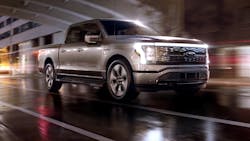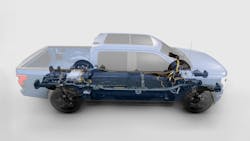Eighty years ago, Henry Ford rolled into Dearborn, Mich., and unveiled what was at the time the greenest vehicle one could imagine. It still had an internal combustion engine, but the vehicle’s paneling comprised a plastic made from soybeans. There was a war coming and steel was scarce, so the founder of Ford Motor Co. came up with an innovative solution, something of which he was never in short supply.
Now skip ahead to 2021, and Bill Ford, the founder’s great-grandson and current executive chair, took to the stage in front of Ford World Headquarters in Dearborn to introduce the automaker’s latest sustainable solution, the long-awaited all-electric Ford F-150 Lightning. This is part of Ford’s $22 billion electrification plan that also includes the Mustang Mach-E sportscar and E-Transit van (available late this year).
It’s not the first electrified pickup, nor is it the first F-150 (or even the 10 millionth), but the Lightning strikes a balance between performance and efficiency.
Here are some of the major highlights:
- 563 hp and 775 lb.-ft. of torque (the latter a high mark for the F-150)
- Range of 230 miles standard; 300 miles with extended-range battery
- Standard duel onboard chargers
- Charges from 15% to 100% in 8 hours with 80-amp and in 41 minutes with 150-kW DC fast charger
- Up to 9.6 kW of onboard power (base trim standard is 2.4 kW); 11 outlets
- 0-60 mph in about 4.5 seconds (with extended-range battery)
- Super crew (four-door) cab; seats 5
- Four selectable drive modes: Normal, Sport, Off-Road and Tow/Haul
- Maximum 2,000-lb. payload; 400 lb. payload in front trunk (“frunk”)
- Up to 10,000-pound towing capacity (on XLT and Lariat trucks with the extended-range battery and Max Trailer Tow Package)
- Available Pro Trailer Hitch Assist that allows tuck to take control of brakes, steering and throttle when connecting to trailer
- Optional Onboard Scales
- 12-in. digital cluster; 15.5 in. center screen
- Over the Air updates
- Phone as a Key
- Starts at $39,974 (before $7,500 tax credit)
“This is a defining moment for our company, a watershed moment for our industry — and on a personal level, it's really gratifying for me,” said Ford during the unveiling on May 19, close to where the Rouge Electric Vehicle Center was built to manufacture this iteration of the best-selling pickup 44 years running. “It's a truck that will usher in a cleaner future for our country. And it will fulfill our promise to our children and our grandchildren, that our generation is committed to leaving them a cleaner planet.”
And while it’s encased in high-strength, military-grade aluminum alloy, not soy, this zero-emission pickup should make any fleet, personal or commercial, cleaner. And with regulations getting more strict over the next decade, the Lightning should provide a utilitarian entry point into electric vehicles.
That is highlighted by the frunk, which adds extra storage to where the engine once was. It’s more than 13 cubic feet for storing extra tools for the job or supplies for an outdoor excursion. The space is waterproof but also has a drain if one were to say, fill it up with ice to cool beverages and perishable foods. No word from the NFL or NCAA if they will allow frunk-gating at games this year.
Zone lighting also helps visibility whatever the outdoor activity is.
With the 1,800 lb. of lithium-ion batteries now stored under the cab, the Lightning has a low center of gravity for better operation on wet roads or sandy dunes.
“We’re not here to make an electric truck for the few — Ford is committed to building one that solves real problems for real people,” said Kumar Galhotra, Ford president, Americas and International Markets Group, Ford Motor Company.
Fleets should also fancy the lower cost of ownership, enabled by 40% less moving parts. As with any electric vehicle, maintenance may be more difficult at the beginning for shops unaccustomed to the sophisticated architecture, so training will be a key to success.
Power play
Range anxiety should be less of a concern with the Lighting as well. Through FordPass, customers will be able to use one of the 63,000 charging points across the U.S., and the Ford SYNC 4 cloud-connected navigation will direct drivers to nearby charge points. The Biden Administration has pushed for an additional 500,000 charging stations to be built by 2030, which should also help customers with charging flexibility.
President Joe Biden test drove the Lightning the previous day when he visited the Rouge. “This sucker’s fast,” he quipped.
One of the more interesting features is the Intelligent Range, which takes into account payload via Onboard Scales, along with towing payload, weather and traffic, to discern current available range. The FordPass management feature will also alert users when battery life drops under one-third.
And if a construction job heads into overtime, the battery can be set up to shut off the Pro Power Onboard system to ensure workers have enough juice to drive home or a nearby charge point.
You’ll notice the max towing is 2,000 lb. less than the 3.5L PowerBoost full hybrid V6 powertrain, but the Lightning does transport 2.6 kW more of energy, making it a self-contained power plant. And for customers who get the Ford Intelligent Backup Power, which requires an installed 80-amp Ford Charge Station Pro, this electric F-150 can provide three to 10 days of power for a home.
“Whether sheltering during a storm or trying to stay safe in a heatwave, customers can now use their truck to give themselves power when they need it most,” said Ryan O’Gorman, Ford electric vehicle manager, strategic partnerships.
More details for commercial customers will be made available on May 24. Reservations are available now, with $100 required to hold an order.
About the Author
John Hitch
Editor
John Hitch is the editor-in-chief of Fleet Maintenance, providing maintenance management and technicians with the the latest information on the tools and strategies to keep their fleets' commercial vehicles moving. He is based out of Cleveland, Ohio, and was previously senior editor for FleetOwner. He previously wrote about manufacturing and advanced technology for IndustryWeek and New Equipment Digest.



